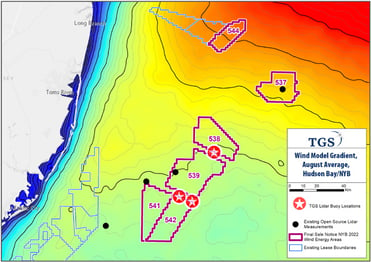Article published in Wind Energy Network, Issue 63, March 2022. Use the link above to view the original.
The US is significantly lagging behind Europe and Asia when it comes to offshore wind energy production, but that is expected to change rapidly. There are currently 18 commercial lease projects in the permitting and development stages and the federal government has set a goal of advancing 26 projects through the regulation process by 2025.
Due to the immaturity of the offshore wind industry in the USA, permitting and development of new projects have been slow. However, the US, particularly the East Coast, is uniquely positioned to solve these delays. Proactive guidance by new Federal policies and the adoption of modern turbine technology could drive exponential growth in the coming years. Crucial to this success is a sound understanding of the wind potential through high-quality measurement data and bias-corrected numerical weather prediction (NWP) model data.
US Catching Up With Europe
The US has been paying close attention to offshore wind progress globally and has initiated new regulations to speed up the permitting and development processes. Additionally, the operators capable of initiating these large windfarm endeavors have already learned valuable lessons and made technological leaps elsewhere in the world.
One essential component for the continued momentum of the project lease, permitting and development activity is accurate weather data. With its head start, Europe has a significant number of physical weather monitoring buoys continually collecting data. The US is far behind in continuous physical measurements, but this presents an opportunity for companies like TGS to collect such data by deploying floating lidars to help bridge this gap.
With a rich history of licensing vast volumes of crucial data to the energy sector, TGS has turned its data insight and expertise to the wind industry. The Company plans to bring a new approach to supplying and funding high-quality wind assessment data to the industry using creative business models that have been well-established in other energy sectors that aim to reduce development expenses by sharing the investment cost of new measurement campaigns.
Data Needs for Bid Assessments
An important component of preparing a feasible bid is to perform a wind assessment to estimate the wind resource across an area accurately and anticipate the energy output of each wind turbine. Lease area assessments are complex, and many factors need to be evaluated, including engineering and technology limitations, financial concerns, scheduling restraints, and environmental and federal regulations.
TGS brings the most important components from these elements together in one place with their new "Wind Axiom" application- quickly evaluating wind resources alongside other key cost differentiating themes.
The company's ambition is to ensure that the necessary data, such as high-quality wind measurements, are made available well before any bidding requirements. This strategy will allow developers to utilize the best available data to assess wind farm performance, which will improve the accuracy of financial performance estimates.
Advanced Weather Modelling
 The Weather Research and Forecasting (WRF) model is the most advanced, physics-based computer model used to explain and predict atmospheric variability. Vaisala and energy data specialists TGS have developed a three-pillar approach that combines the sophisticated WRF model with onsite observational data and machine-learning algorithms. This approach provides a reliable and cost-effective assessment that can meet the demands of the competitive market to review large areas in a short time window.
The Weather Research and Forecasting (WRF) model is the most advanced, physics-based computer model used to explain and predict atmospheric variability. Vaisala and energy data specialists TGS have developed a three-pillar approach that combines the sophisticated WRF model with onsite observational data and machine-learning algorithms. This approach provides a reliable and cost-effective assessment that can meet the demands of the competitive market to review large areas in a short time window.
This particular three-pillar method integrates the rich datasets from WRF with measurements taken from LIDAR buoys and other weather stations. It uses supercomputers to run advanced machine learning algorithms on the data. The wind assessment generated from this approach provides increased accuracy of wind behavior and variability, regardless of proximity to physical measurements. This approach reduces the cost and time involved in deploying measurements while maintaining the accuracy needed to maximize energy production from the wind farm.
With greater visibility on future lease activity, TGS hopes to deploy additional LIDAR equipment at key strategic locations around the US coast and, potentially, around the globe. This strategy will dramatically augment future WRF simulations and significantly boost the quality and efficiency of future wind development planning.
A Bright Outlook
As illustrated by the New York Bight lease auction held in February 2022, competition and desire to construct new offshore wind projects in the US is high- painting a positive future for both existing and new offshore wind leases across the US. A windfall of positive enforcement from federal and state regulators combined with the drive from energy data companies like TGS to provide enhanced insights through reliable, high-quality data will provide the additional tools necessary to meet the 30GW goal by 2030.
As seen in Europe, the utilization of detailed wind resource data in the development process makes it possible to mitigate risk and increase energy production and profitability while reducing overall energy costs to consumers. The US hopes to benefit significantly from the lessons learned in Europe to enable exponential growth in offshore wind development over the next ten years.

